Menu
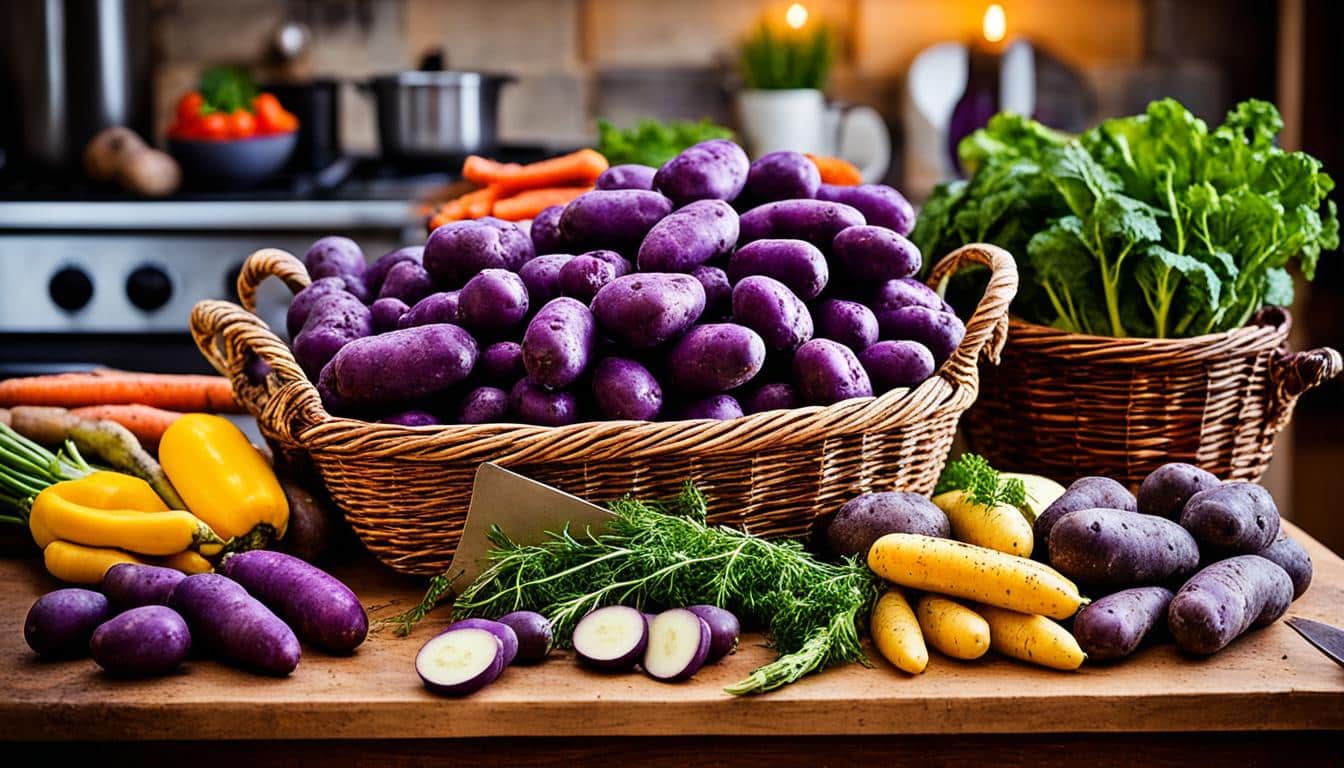
Did you know heirloom vegetables are vital because they help protect different plant types? They are not like the usual hybrids you see in big stores. Heirloom plants offer tastes that are deeply connected to history. They come from a time where food was grown naturally without chemicals.
Heirlooms, known for their superior taste, make dishes special. Think of the rich flavour of heirloom tomatoes or the bright colours of carrots. You won’t often find these in ordinary stores. To get them, people usually visit local events, special shops, or farmers markets.
Growing heirloom veggies at home links us to the ways of our ancestors. It keeps old plant traditions alive, ensuring we keep a variety of crops. Besides their great flavours, these plants are a way to remember the past. They turn meals into stories of history.
Heirloom vegetables connect us to the past through plants. They are grown from old seeds, offering a variety not seen in today’s farming. These plants bring back colourful and tasty options that were once common but are now rare.
Heirlooms come from open-pollinated seeds. This means they keep their original traits through natural breeding. Unlike store-bought varieties, which are designed for looks and travel, heirlooms focus on flavour and nutrition.
Focusing on heirloom gardening fights the effects of modern farming. It helps save old farming ways and increases food variety. This way, we support the planet and get to taste better foods.
Take the carrot for example. Heirloom carrots aren’t just orange; they can be white, violet, or yellow. In places like South Africa, you can get ‘rainbow carrots’ to make dishes more interesting. Heirloom tomatoes are another exciting heirloom. They come in many shapes, sizes, and names not usually seen in stores.
Summer squashes show the same diversity. They include baby marrow and other unique types. Growing these squashes means continuing a tradition of rich flavour and food variety.
Cooks love using heirlooms for their great taste. They remind us of history on our plates. Each meal becomes a way to honour the past and support sustainable practices.
| Attribute | Heirloom Vegetables | Commercial Varieties |
|---|---|---|
| Seed Source | Passed down through generations | Modern hybrid seeds |
| Flavour | Exceptional and diverse | Often less flavourful |
| Pollination | Open-pollinated | Controlled hybridisation |
| Biodiversity | High, promoting varied traits | Low, focused on uniformity |
| Sustainability | Contributes to sustainable food systems | Supports large-scale monocultural production |
The story of heirloom vegetables goes back for thousands of years. It’s about a tradition that values both our past and our future. Heirlooms have helped shape sustainable food practices by honouring our agricultural and culinary past.
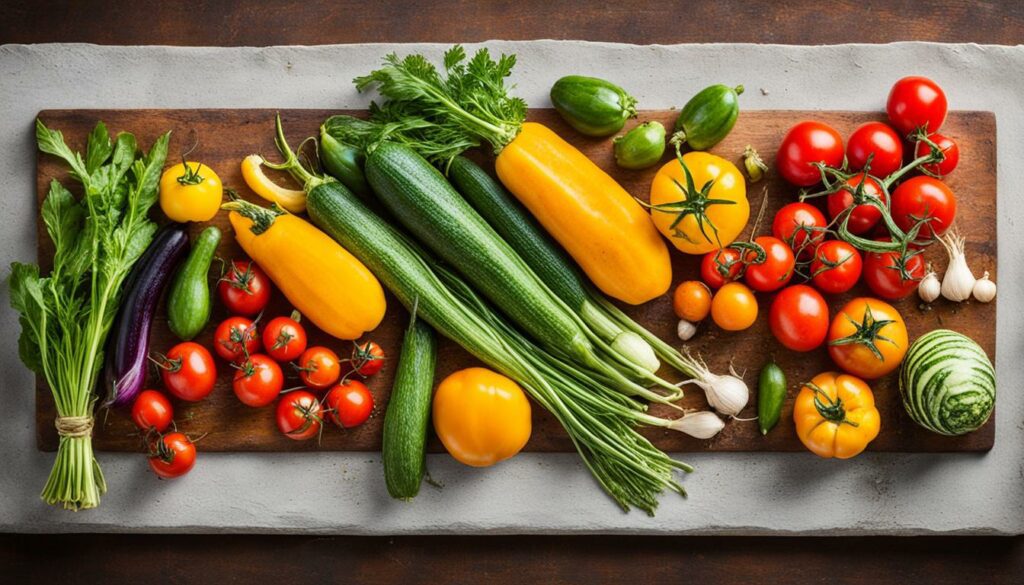
Heirloom vegetables are special seeds saved by caring gardeners and farmers. They try to keep the best ones alive. You won’t often see these in big stores. But you’ll find them thanks to small farmers and home gardeners.
This unique group keeps these seeds passing from hand to hand. They do this to keep their flavours and types true. That’s why heirlooms taste so good and look different. They’re loved by those who grow food and people who pick it out in markets.
Heirloom vegetables are not just delicious; they’re part of human history. For example, plants like the Cherokee Trail of Tears Pole Bean have a story to tell. They connect with past events and cultures.
These vegetables also do a lot for our planet. Their open-pollinated nature means they keep our plant world diverse. They can adapt well to different places and times. And, they grow reliably, keeping their unique qualities alive for new generations.
By cooking with heirloom veggies, we make our meals more special. Plus, we play a part in saving these important plants. Choosing to buy from small farms supports this great cause. It ensures that these farming traditions live on for the years to come.
Heirloom vegetables bring superior flavor and enhanced health benefits to the table. They offer a unique taste that many modern hybrids lack. This makes cooking with them a special experience.
Heirloom vegetable cooking tips focus on their rich flavours and scents. They grow in specific local conditions which make their tastes unique. Sustainable farming makes these flavours even better.
Some, like the Dragon Carrot and the Purple Russian Tomato, have intense flavours. They are less watery, making their taste stand out. They are grown at the right time, making their taste perfect naturally.
Heirloom vegetables are grown naturally, needing fewer chemicals. This makes their taste pure and their environment full of nutrients. Their rich soil and farming passed through generations make them nutritious.
These practices lead to more diverse nutrients, making their taste and health benefits even better. Genetic variety ensures each type has a unique taste.
| Traits | Heirloom Vegetables |
|---|---|
| Flavour Concentration | High, due to lower water content |
| Adaptation | Local climates and soil |
| Cultivation Practices | Sustainable, fewer chemicals |
| Health Benefits | Enhanced by diverse nutrients |
Heirloom vegetables are known for their unique tastes and features. They’ve been grown for generations. Because of this, they add a special touch to any dish, simple or fancy.
There are many interesting heirloom vegetables to try. Some favourites include:
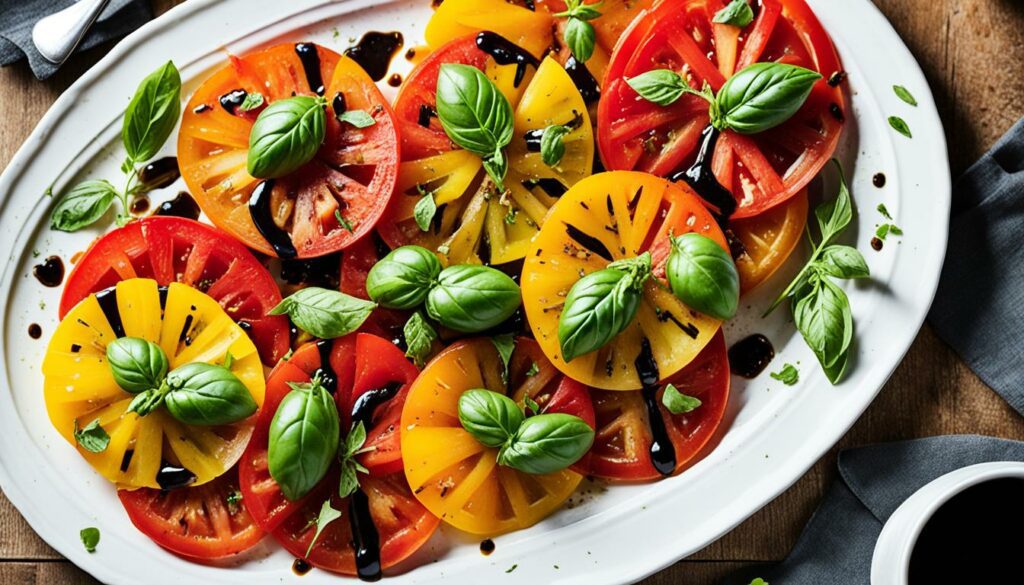
Seasonal heirloom vegetables are key for tasty, fresh dishes. Here is a look at what’s in season:
| Vegetable | Days to Maturity |
|---|---|
| Gold Medal Tomato | 75 to 90 |
| Early Scarlet Globe Radish | 20 to 28 |
| Rattlesnake Snap Bean | 60 to 90 |
| Dragon Carrot | 90 |
| Japanese Climbing Cucumber | 58 to 65 |
| Jimmy Nardello Pepper | 80 to 90 |
| Mountain Rose Potato | 70 to 90 |
Using these veggies in your recipes brings out the best in each meal. Try different types to make every dish memorable. Heirloom vegetables can turn your meals into unique experiences.
Selecting the finest heirloom vegetables requires a keen eye for details. These unique varieties have a history of several millennia. They are loved for their exceptional taste, vibrant colours, and natural stability. To make the best heirloom vegetable recipes, start by picking fresh produce and knowing where to get it.
Look for heirloom vegetables that are firm and full of colour. A strong, fresh scent is a sign they’re high-quality. Many food gardeners love heirlooms for their great taste. These veggies can grow true-to-type each time, thanks to natural stabilisation from seed saving. This keeps their quality consistent.
Farmers markets are the best place for fresh heirlooms. Purchasing from local growers means the veggies were picked when best. Plus, it supports sustainability and keeps local farming alive. Heirloom recipes shine with ingredients from these markets.
Buying from trusted local farmers avoids confusion about hybrids. And, you can find unique varieties like Mammoth Red Rock Cabbage and Purple Climbing Beans. They add varied flavours and are easy to grow. Exploring heirloom recipes is both fun and enriching this way.
Here’s a brief guide on selecting top heirloom vegetables:
| Indicator | Description |
|---|---|
| Firmness | A firm texture denotes freshness and quality. |
| Colour | Bright and vibrant colours indicate rich nutrients. |
| Aroma | An intoxicating fresh aroma suggests peak ripeness. |
| Source | Buy from local and trusted farmers markets for best quality. |
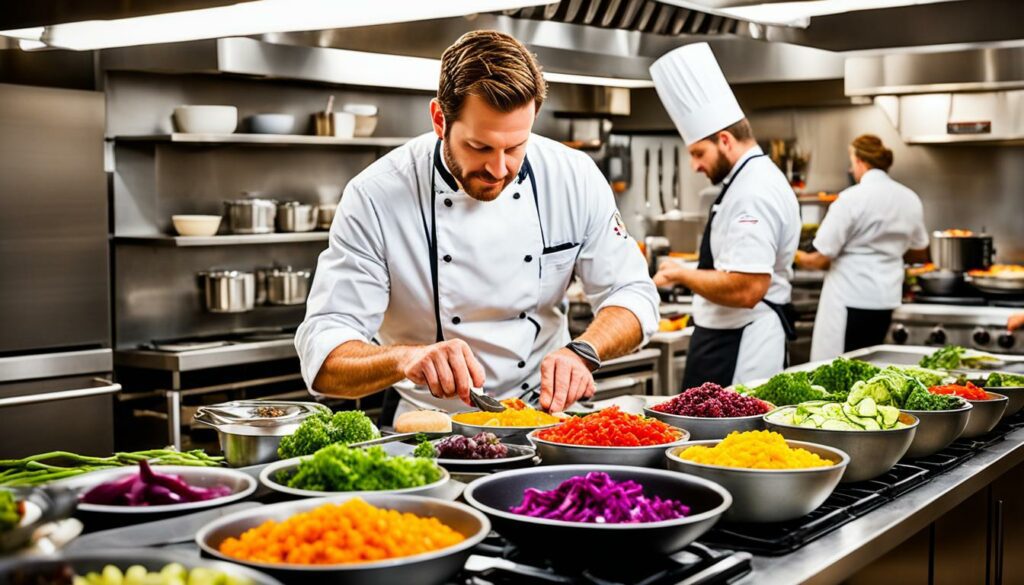
Growing heirloom vegetables is special. Their amazing flavours and textures stand out from regular shop veggies. Handle them with care and see their quality shine more than ever.
First, clean your heirloom veggies well. They’re often fragile, so a light rinse is best to avoid damage. Use a soft brush on tougher types like carrots or potatoes. This ensures they’re perfectly clean.
Cutting them right is also essential. For leafy greens, like Lacinato kale, cut out the central stem and slice thin. With tomatoes, a sharp knife is crucial. It stops them from getting squashed and keeps their juices in.
Proper storage keeps heirloom vegetables fresh. They are more prone to damage and disease. So, keep them cool and dry.
Place root vegetables in breathable bags in the fridge. Wrap leafy greens in a damp cloth and use the crisper drawer. Tomatoes and softer kinds stay at room temperature until ripe. Then, keep them in the fridge to stay fresh longer. Check them often to avoid spoilage and enjoy their quality for longer.
Heirloom vegetables stand out for their wonderful taste and how well they grow almost anywhere. You can use different cooking styles to highlight what makes them special. This way, old veggies become new culinary delights through methods like roasting, stir-frying, and grilling.
Roasting brings out the best in heirloom veggies, making them sweeter and more flavourful. It uses high temperatures to turn their natural sugars into a caramelized crust. Yet, they keep soft and juicy inside. Carrots, beets, and tomatoes are great for roasting. Try tossing them in olive oil, add a pinch of salt and pepper, then roast at 200°C for 20-30 minutes. The time depends on how big they are.
Stir-frying is super for quick-cooking heirloom veggies that love a bit of heat. This fast method keeps their nutrients and colours. Use veggies like kale and Swiss chard plus some garlic and ginger for a boost. It’s a speedy, healthy way to make a meal, only taking 5-7 minutes.
Grilling heirloom vegetables is perfect for summer, giving them a smoky hint. Tomatoes, squash, and peppers are great for this as they’re firm. Just slice them, marinate with olive oil, herbs, and spices, then grill for 5-10 minutes each side. The time depends on how thick they are.
These cooking methods each bring something unique. Roasting adds a sweet, caramel flavour. Stir-frying keeps them colourful and fresh. Grilling brings out a smoky, rich taste. Trying these ways lets you really see the variety heirloom vegetables offer.
| Method | Description | Suitable Vegetables | Approximate Cooking Time |
|---|---|---|---|
| Roasting | Caramelizes sugars and creates a charred exterior | Carrots, Beets, Tomatoes | 20-30 minutes |
| Stir-Frying | Quick-cooking over high heat retains nutrients and vibrant colours | Kale, Swiss Chard | 5-7 minutes |
| Grilling | Imparts a smoky flavour with sturdy texture | Tomatoes, Squash, Peppers | 5-10 minutes per side |
Discover the world of heirloom vegetable recipes. It’s filled with flavours rich in history and taste. Let’s explore some delicious dishes made from heirloom produce.
This dish is simple yet full of flavour. It brings out the vibrant colours and diverse tastes of heirloom tomatoes. Mix them with basil, mozzarella, and a light balsamic vinaigrette for a twist. It shows that these tomatoes are way better than the ones you find at the store.
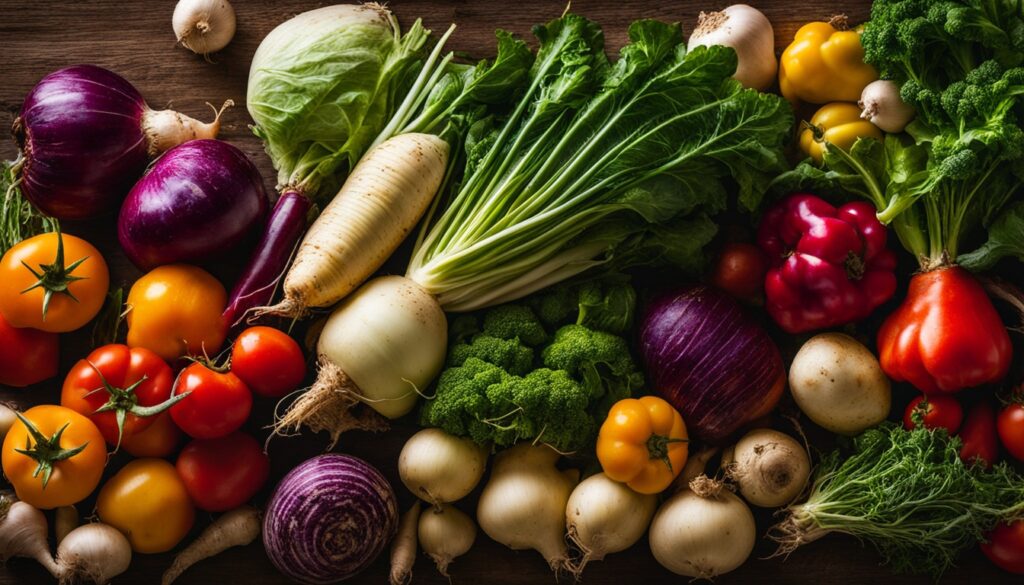
Here’s a recipe that shows the diversity of heirloom vegetables. Use carrots, bell peppers, and snap peas to make a colourful stir-fry. You can use frozen peas instead of fresh ones if needed. Just make sure they’re cooked before adding them to the mix.
A fish stew with heirloom carrots is both delicious and filling. Start with sautéed onions and garlic, then add tomatoes and fish stock. The heirloom carrots make it richer and more nutritious. It’s a great family meal.
Each recipe highlights the unique taste of heirloom vegetables. They combine tradition with contemporary flavours. These dishes prove that heirloom vegetables are more than just fresh produce.
Heirloom vegetables have unique tastes worth celebrating. To truly enjoy them, we need to use the right seasonings and cooking methods.
Try enhancing their flavours with sea salt, black pepper, and quality olive oil. This approach keeps the vegetables’ special tastes at the forefront.
Choosing the right seasonings is key. Mix vegetables with strong herbs like basil and rosemary. This step brings out their natural deliciousness. For example, adding basil to a tomato salad makes it much tastier.
How we cook these vegetables matters, too. Roasting can make carrots and peppers sweeter. It brings out their rich flavours and makes them smell great.
High-quality fats like butter and olive oil also do wonders. Sautéing beans in garlic butter, then squeezing lemon over them, is pure joy.
Cooking heirlooms in a way that respects their heritage is important. These vegetables come with old recipes and stories. Cooking them well acknowledges their history and connects us to it.
“The exceptional flavour and aroma of heirloom vegetables often surpass that of supermarket produce, providing a unique gastronomic experience.”
Working with heirloom vegetables is a satisfying process. It connects us to history while offering modern culinary pleasures. Season well, choose good ingredients, and cook with care to enjoy their full potential.
Heirloom vegetables bring a taste of the past to your table. They make meals rich in both flavour and history. Below are some tasty recipes that showcase the uniqueness of heirloom veggies.
This dish is great for warm days. It’s a light meal or a tasty side. The mix of heirloom veggies not only tastes great but looks beautiful too.
Preparation: First, cook and cool the pasta. Then, mix it with veggies, basil, and onion. Finally, add the feta and seasoning. Chill before serving for the best taste.
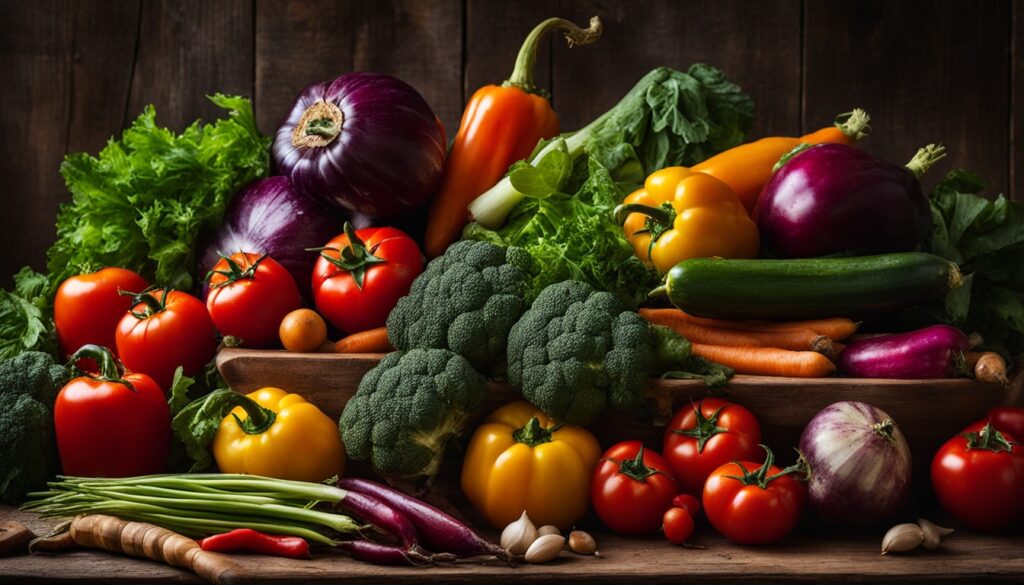
This salsa is a rainbow on your plate. It’s colourful, healthy, and good for any gathering. Enjoy this flavourful dish in the warm months or as a quick bite.
Preparation: Mix tomatoes, peppers, onion, and herbs in a big bowl. Stir in lime and salt. It’s ready to eat with chips or on top of grilled food.
These ideas turn your table into a feast for the eyes and the taste buds. They nod to the past while being healthy and delicious. Celebrate diversity with every bite!
Heirloom vegetables have a deep history and taste amazing. To cook them well, you need to use special methods. Here are some top tips I have for cooking with heirloom vegetables.
It’s key to get the cooking times right for heirloom vegetables. They are often more delicate than newer types. For example, heirloom tomatoes keep their shape better if you cook them briefly.
Steam or blanch heirloom greens to keep them tasty and full of nutrients.
Pairing heirloom vegetables with the right ingredients is important. Use garlic or shallots to make the flavours pop without taking over. For a tasty dish, mix heirloom carrots with herbs like thyme or rosemary.
Add quality olive oil and a bit of sea salt to highlight the vegetables’ sweet and complex flavours. This approach makes your meal both delicious and a celebration of tradition.
When cooking with heirloom vegetables, focus on their unique qualities. Using these tips, your dishes will be not just great-tasting. They will also pay homage to the deep history of these ingredients.
| Aspect | Heirloom Vegetables | Hybrid Vegetables |
|---|---|---|
| History | Spanning decades to centuries | Relatively modern |
| Pollination | Open-pollinated, natural | Controlled cross-pollination |
| Flavor | Exceptional, diverse flavours | More uniform, less pronounced flavours |
| Agricultural Impact | Sustains cultural and agricultural legacy | Focuses on yield and uniformity |
| Adaptation | Well-adapted to regional conditions | Bred for broader adaptability |
Preserving heirloom vegetables is vital. It allows us to enjoy them beyond their season. The demand for such veggies grows as people look for unique tastes and food heritage. So, it’s key to find ways to keep them fresh longer.
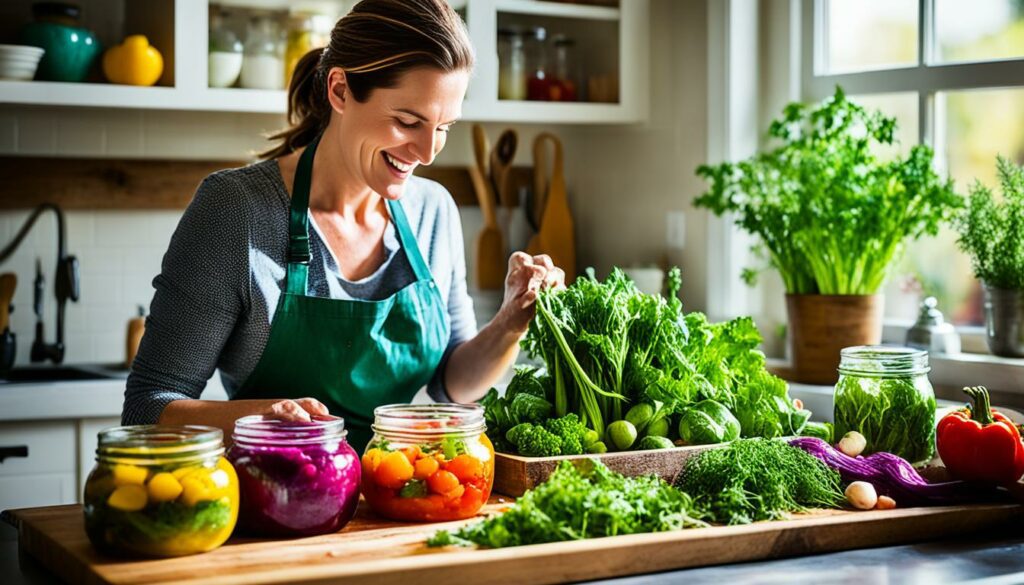
Freezing is a top pick for keeping heirlooms. This method keeps their nutrients and tastes intact. To freeze, blanch them to keep their colours and tastes before storing. Canning, with the right jars and sterilisation, is great for long storage.
Turning heirlooms into sauces and jams is another great idea. It not only secures your supply but also is versatile for many recipes. For example, can tomatoes, beans, and squash into sauces, and cucumbers and melons into tasty jams. These add unique flavours to dishes and last a long time.
Remember, preparing heirlooms for storage can be intense. But the effort is worth it for their rich, unique tastes all year. For detailed tips, check out this heirloom preservation guide.
| Preservation Method | Suitable Heirloom Vegetables | Key Benefits |
|---|---|---|
| Freezing | Sweetpotatoes, Winter Squash | Retains nutritional value, easy to store |
| Canning | Tomatoes, Beans | Long-term storage, maintains flavour |
| Making Sauces | Squash, Cucumbers | Versatility in recipes, preserves heritage flavours |
| Making Jams | Melons, Cucumbers | Extended shelf-life, unique taste profiles |
Using these methods, we keep heirloom vegetables a key part of our meals. They continue to share their special tastes and history with us.
Adding heirloom vegetables to our daily meals makes them tastier and healthier. I love using heirloom tomatoes now that it’s their season. But remember, their season is short, so use them as much as you can.
I thought I would share with you all 6 tasty & easy recipes that incorporate heirloom tomatoes.
Heirloom tomato soup is a regular hit and heirloom tomato gazpacho is perfect for a fast lunch. Both of these dishes show off the uniqueness of heirlooms in simple meals.
Salads are a great way to enjoy heirlooms, like a quinoa salad or a simple avocado toast. The bacon, avocado, and tomato toast is also a sure hit for any family.
Chickpea flour pancakes are a light and healthy option, especially for those on a special diet. Top them with a green goddess dressing for a tasty meal. I learned this from my naturopath, confirming the variety of ways heirlooms can be used.
Zucchini, beets, and carrots can easily be added to meals to increase both taste and health. Mushrooms can cut down on meat in dishes, making meals healthier without losing taste.
Pureed orange vegetables can make comfort foods healthier. They lower bad fats and salt in dishes like mac and cheese. And don’t forget, smoothies are a fun way to get more veggies and fruits into your day.
By using heirloom veg, meals become more than just food. They become a link to the past with added nutrition. It shows just how special and versatile heirlooms are in cooking.
Cooking heirloom vegetables is a careful task. They are special, grown to thrive in specific places. This means less need for chemicals, helping the environment. It also shows good farming practices.
Selecting the right way to cook them is crucial. Whether you roast, stir-fry, or grill, respect their unique flavours and form. I enjoy using these methods. They really bring out the vegetable’s sweetness and texture.
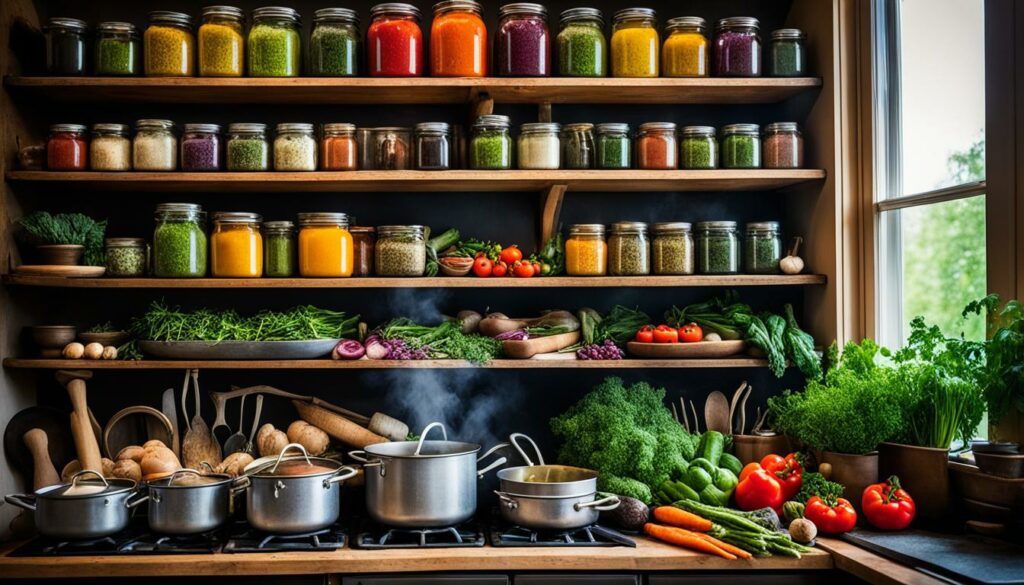
Finding heirloom vegetables can be hard. You usually have to look in special places like local markets. The taste is much better than normal veggies. This is thanks to farmers and gardeners who work hard to keep these old seeds alive.
Cooking with heirloom vegetables is like making history come alive. These special plants link us to the food of the past. Learning their cooking ways has made my food journey more meaningful. It adds a unique and real taste to my dishes.
Cooking with heirloom produce is not just a meal; it’s an experience. However, it brings some unique challenges. Finding rare varieties and keeping their unique tastes alive are key tasks. This adds to the joy of cooking and eating heirloom vegetables.
Finding rare heirloom vegetables is a big hurdle. Heirlooms are varieties created before 1940 and don’t come easily due to their age. For example, specific heirloom winter squash from the Southwest U.S. and northern Mexico are available at Native Seeds/SEARCH. In Central Texas, sweet potato varieties like Hernandez and Violetta can be found at Southern Exposure Seed Exchange.
More people are interested in heirloom dishes thanks to local markets and a love for unique tastes. When producing, it’s important to know your market and invest wisely. Baker Creek Heirloom Seeds, for instance, provides unique corn varieties attractive to certain buyers and at higher prices.
Keeping the original taste of heirloom produce is a big deal. They don’t have the disease resistance modern hybrids do. This means you must be careful when growing and cooking. Even though heirloom tomatoes cost more, their taste and effort are clearly shown.
To keep the special flavours, growing and cooking must be done thoughtfully. Each heirloom vegetable type, from sweet potatoes to collard greens, has its season. In the kitchen, these same careful ways should continue. This is crucial for keeping the real flavour of heirloom dishes.
Helping local farmers and saving heirloom seeds is vital. Organizations like Seed Savers Exchange offer classics such as Rattlesnake Snap green beans. This keeps the seeds for future use.
Despite the challenges, cooking with heirloom produce is very rewarding. It brings unmatched flavours and cultural value to the table. By supporting local farmers and saving these seeds, we keep these dishes alive for the future.
In my journey with heirloom vegetables, I’ve discovered real treasures. They bring a variety of tastes and stories to our tables. Tips for cooking heirloom vegetables often talk about their unique flavours and health benefits. By using these ancient types, my food tells a story that’s rooted in history.
Sourcing and preserving the flavour of these plants can be hard, but it’s worth the effort. Many gardeners love growing heirlooms because of their superior taste and the tradition of sharing seeds. These vegetables are not only tasty but also healthier than many modern ones. For example, you can enjoy meals like heirloom tomato salads and bean soups. They are a great source of nutrition and taste.
The variety in heirloom vegetables is amazing, from bright tomatoes to different squash types. These add colours and flavours to my cooking. Because they breed naturally, their unique traits are well-preserved. They often do better in some areas than the usual crops. This helps keep old vegetable types alive and prevents them from disappearing. Using heirloom vegetables means supporting nature and the diversity of our food. It’s an act that makes our meals better and helps protect our food’s heritage.
Heirloom vegetables are unique plants that have been grown for several years. They offer great taste, look beautiful, and are easy to grow. These seeds are not changed by science, so they keep their natural features.
Heirloom vegetables are vital for keeping our variety of plants alive. They also help us remember our past by their taste and look. By growing naturally, they support a healthy farming system.
Tomatoes, carrots, and bell peppers are well-loved heirloom vegetables. They all taste different and can make any meal better.
Choose those that are not soft, but are firm and full of colour. A good smell also shows they are ripe. Buying from local markets helps support farmers who grow them well.
Firstly, gently clean them to get rid of dirt but keep the skin safe. Learn how to cut them well for better taste and look. Store them right to keep them fresh and tasty.
Roasting, stir-frying, and grilling can make heirloom vegetables tasty. Each way of cooking brings out their special flavours and textures.
Absolutely! Try a simple tomato salad, a colourful stir-fry, or a fish stew with carrots. These meals are healthy and full of flavour.
Use the right seasoning and herbs to make them taste even better. Cook them in ways that show off their natural taste.
Make a summer pasta salad or a rainbow salsa with heirloom vegetables. They not only taste good but look great too.
Cook them just enough to keep the taste and nutrients. Choose ingredients that make their unique flavors stand out.
Freezing, canning, or turning them into sauces or jams are great for keeping them longer. This way, you can enjoy their goodness any time of the year.
Add them to your usual dishes or try new recipes with them. They will bring more flavour, health, and a touch of history to your meals.
Finding rare varieties and keeping their true taste can be hard. This is why it’s important to support those who grow them and protect their seeds.